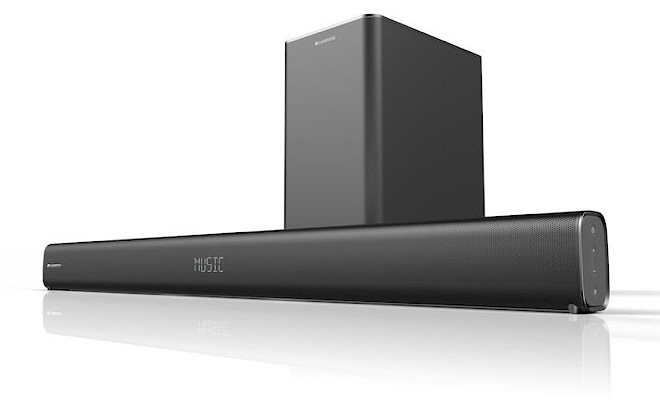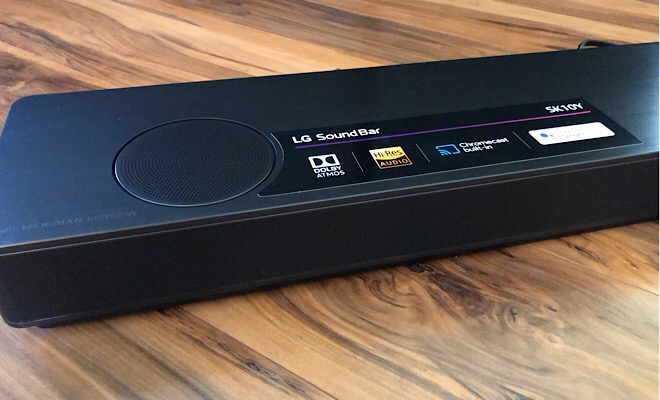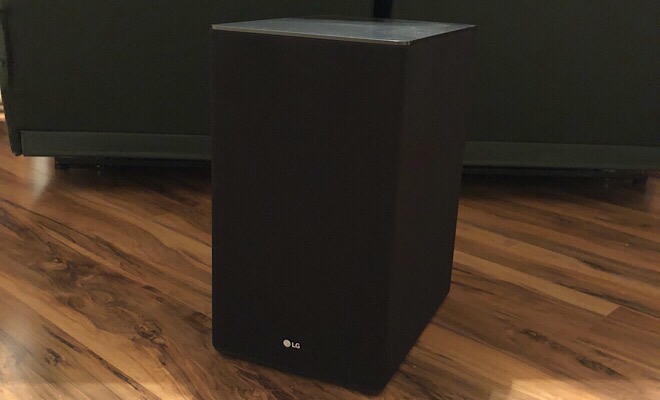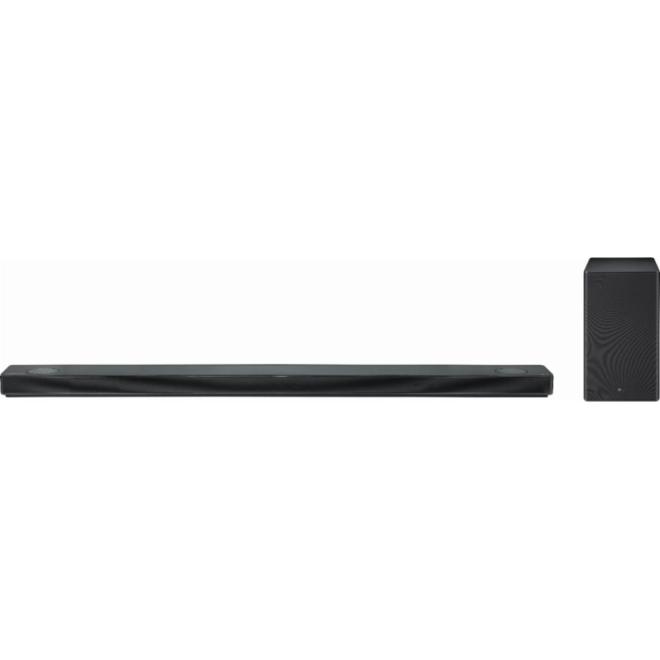LG SK10Y Dolby Atmos Sound Bar + Optional Rear Wireless Speakers
Overview -Overview - Hefty, packed with power, and, when paired with the optional ”wireless” speakers, featuring 7.1.2 dedicated channels of audio, the LG SK10Y sound bar with wireless subwoofer outputs high-resolution audio while fitting the design requirements for those seeking a stripped down set-up without sacrificing the capability to enjoy Dolby Atmos tracks. Unfortunately, dialogue volume issues, an awkward rear speaker setup, an LED display that won't fade to black, and lack of DTS:X support significantly diminish enthusiasm for this big-ticket item and should make consumers think long and hard before pulling the trigger. After exploring this sound bar from every angle, we say skip it.

Intro
LG has long been a leader in OLED TVs. I have two of them in my home and believe they’re the best on the market. I just purchased the 2018 LG65E8P and am using that as my primary home theater display. But my 2016 LG 65E6 still works great (and is 3D-capable), so I want to maintain the ability to enjoy 4K UHD, HD, and 3D movies in all their crystal clear glory on that TV, but without the clutter of a traditional 5.1.2 audio configuration. A sound bar seemed to be the logical alternative, but I wanted one that would allow me to experience Dolby Atmos soundtracks and feature small, wireless rear speakers for a true surround experience. Enter the LG SK10Y with Meridian Technology, a massive, powerful, yet sleek and stylish sound bar with wireless subwoofer and optional wireless rear speakers. On paper, this looked like my dream sound bar, but a few critical issues have kept me from falling in love with this impressive unit. In fact - just between you and me - I'm planning on breaking up with it as soon as I finish this review.

Specs, Design & Setup
The SK10Y is one BIG sound bar. It arrived on my doorstep in an enormous rectangular box that was both unwieldy and very heavy. Once I managed to get it inside, unpacking was surprisingly easy. In addition to the sound bar and subwoofer, the box includes a remote with batteries, power cord, 59" optical cable, wall mounting template and hardware, wire ties, and a fold-out quick-start guide. (The full manual is only available online.) Just be careful if you have to move the sound bar to another room; at almost 58" wide and 16-1/2 pounds, it's very awkward to carry, making it easy to scrape a wall, knock over a lamp, or bump the bar into something else. The unit's low profile (2-7/16" high and 5-13/16" deep) keeps it from blocking any portion of your TV screen, but its massive width could be problematic for some set-ups. The SK10Y frames my LG 65" OLED TV perfectly (the sound bar is specifically designed as a companion for LG's large format displays), but it's too wide for my TV stand. Both sides hang off the edges by a couple of inches. If you have a smaller TV, the sound bar could look strangely disproportional. The last thing I would want is for a sound bar to make my television look dinky.
The SK10Y is a good-looking piece of hardware. A black matte finish and fixed grill lend it a sleek and stylish appearance, and the two circular upward-firing Dolby Atmos speakers are clearly visible on the top of the unit. In addition, the sound bar features right, center, and left speakers across its front and a side speaker at each end for directional effects. (Unfortunately, my TV sits angled in a corner, so the side speakers are pointed directly at walls, which pretty much nullify their impact.) Dolby Atmos - along with Dolby TrueHD and Dolby Digital Plus - is supported, but oddly, DTS:X is not, so any DTS:X soundtrack will be downgraded to DTS Digital Surround. (I would imagine a future firmware upgrade would rectify this issue, but none has been announced as of this writing.) The lack of DTS:X support might not be a deal-breaker for some, but if you plan to shell out almost a grand for a sound bar, it would be nice if it could handle any audio format you throw at it.
The SK10Y features Meridian Technology, which is designed to provide a higher and wider audio experience, and can play high-resolution audio files up to 24-bit. It also has full 4K pass-through, Bluetooth and wireless capability, a phone app that will control the unit, built-in Chromecast, and the ability to work with Google Assistant. Total power output is 350 watts. On the back of the SK10Y, there is one HDMI out port (ARC compatible), two HDMI in ports (I would prefer three, so I could run a Blu-ray player, streaming device, and cable/satellite box through the sound bar), an optical port, an Ethernet port, and a portable jack. The wireless 200-watt subwoofer is also fairly sizable, measuring 8-3/4" wide x 15-7/16" high x 12-5/16" deep and weighing 16-1/2 pounds.
The optional 70-watt, wall-mountable rear speakers (LG SPK8-S), which run around $179, claim to be wireless, but that's a bit of a misnomer. (I'll explain soon.) Inside the package, in addition to the compact speakers, which measure 3.5"W x 4.8"H x 3.2"D and weigh a scant two pounds, there's a wireless receiver (2.4"W x 8.7"H x 6.9"D, 2.1 pounds) and gobs of very thin speaker cable.
Why the speaker cable for the "wireless" speakers?
Well, while the receiver is capable of receiving and transmitting a wireless signal, the speakers themselves are not; therefore, they must be plugged into the receiver with the supplied cable to operate. So they are, in essence, wired wireless speakers. It's a necessary evil for wirless rear speakers to need either a power source or some type of reciever/amp, but we found this system cumbersome, messy, and not everyone has floor outlets in the center of their TV room or tables directly behind their sofa upon which the rears can be perched. (This is how LG illustrates the configuration in their setup leaflet.) If your rear speakers happen to sit at opposite sides of your viewing space (as mine do), the cables must snake around the room to connect to your receiver. Ultra-thin or not, the cables still show and look ugly. The best solution for a truly clean appearance would be in-wall wiring with exposed banana plugs at the speaker sites and near the receiver (which I also have), but that involves cutting and stripping the cables to connect them to the plugs (not included, of course). I did not try that set-up for the purpose of this review, but it is the best option for maintaining the illusion of wireless speakers. The receiver, however, while relatively compact, is just one more component to add to the system. Along with the sound bar, subwoofer, and rear speakers, that makes five pieces of equipment, which feels more like having a traditional A/V reciever and speakers. The sound bar scenario is supposed to eliminate all that.

Hooking up the sound bar is super simple. Just plug the sound bar and subwoofer into wall outlets or a power strip. If you're using the rear speakers, connect them to the receiver using the supplied cables and plug that in as well. The SK10Y will automatically detect both components (a green light on each means you're good to go), then just choose which components to connect to the sound bar and which to connect directly to the TV. I ran my Oppo UDP-203 Blu-ray player and Apple TV streaming device through the SK10Y and hooked my DirecTV HD DVR up to my LG OLED 65E6P television. Some sync problems initially resulted, especially with the DirecTV connection, and the SK10Y's AV Sync function could not resolve them. Luckily, my E6P TV has a very good sync adjustment feature, so I was able to perfectly sync the audio. If your TV has a similar feature, I would highly recommend using that over what the SK10Y offers. It will save a lot of frustration.
The remote fits nicely in the palm of your hand, but has limited capabilities. The power, volume, mute, skip, and play/pause buttons all have raised symbols so they're easy to navigate in the dark. The function button, denoted by a large F, is also raised and allows you to cycle through the sound bar's various inputs. Unfortunately, there's no direct access to Bluetooth, HDMI 1 and 2, etc.; you must press the F button repeatedly until the LED light displays the desired input. Kind of a pain. The Sound Effect button lets you choose from five different soundscape options - Bass Blast, Standard, Movie, Music, and ASC (Adaptive Sound Control), which automatically changes the setting to suit the media being played - while the Auto Volume button prevents sudden increases in volume, and the Auto Power button will simultaneously turn your LG TV on and off along with your sound bar. A level control button allows you to manipulate treble and bass, as well as the output of the subwoofer and left, right, upward-firing, and rear speakers. A recent, much-ballyhooed firmware update now lets you also control the volume of the center speaker, through which dialogue emanates (more on that below). The phone app offers much more comprehensive features (including a Sleep Timer and Night setting) and more direct access to some of the remote's functions. I may be in the minority, but I'd prefer a better remote over a slick phone app, mainly because I don't want to be distracted by news alerts, sports scores, and text messages when I just want to adjust the audio for the movie I'm watching.
Another thing that bugs me big time about this sound bar is that there's no way to adjust the brightness of the LED display. When a function is activated, the light on the display turns bright, then dims after a few seconds, but it never completely goes out...and there's no button to control that. To some, this might be a minor annoyance, but it's practically a deal-breaker for me. I admit I'm a bit over the top when it comes to errant component lights disrupting my viewing experience, but in a dark room the dimmed display really stands out, especially because the sound bar is located directly beneath the TV screen. Except for putting a piece of black felt over the offending light (and believe me, I've done that in the past with other irksome components; just ask my wife), there's no way to get rid of the illumination. Hopefully, another firmware update will address this nagging problem, because I can't believe I'm the only person who feels so passionately about it.

Performance
Controversy surrounded the SK10Y's release because, initially, the center channel - through which all the dialogue for movies and TV shows is funneled - was the only channel that could not be boosted or diminished by the user. The volume of all the other channels could be raised or lowered via the remote, but for some inexplicable reason, not the center channel. This caused an uproar, because the audio effects of action, fantasy, and superhero movies consistently drowned out the dialogue, rendering these coveted 4K UHD discs virtually unwatchable. It took a few weeks, but finally, LG issued a firmware update, much to the relief of many an apoplectic consumer. Yet here's the thing. The update doesn't completely fix the problem. Yes, you can now adjust the volume of the center channel, but the increments are not substantial, so that even when the channel's limits are maxed out, dialogue can still be difficult to decipher during intense effects-laden scenes. There's only one word for that: unacceptable. Nothing ruins an edge-of-your-seat sequence in which the main characters face impending doom like having to strain to hear their frantic cries, quips, and directives.
Cable/satellite TV is especially offensive in this regard. While channel surfing HBO and Showtime for this review, I watched portions of Wonder Woman and Fast & Furious. For both films, the music was quite forward and flaunted excellent fidelity and dynamic range, bass frequencies swelled appropriately, and directionality across the front of the sound bar was crisp and distinct...but the dialogue was muted, even with the center channel volume maxed out. What's worse is that even with the overall volume pushed to its highest level, the sound wasn't loud enough to provide the oomph the movie required. In the opening scene of Fast & Furious, Dom and Letty are screaming at the top of their lungs and yet I'm on the edge of my chair with my ear thrust forward straining to hear what they're saying. For such a powerful sound bar, that just shouldn't be. Forget busting an eardrum (which I should have the freedom to do if I so choose), I just want to fully enjoy the movie. The SK10Y doesn't let me do that - at least on DirecTV - and it really disappointed me.
The same issues plagued both 4K UHD Blu-ray discs and movies streamed over Netflix via Apple TV, although to a slightly lesser degree. I tested segments of Hacksaw Ridge, The Fate of the Furious, Alien Covenant, and Fantastic Beasts and Where to Find Them on 4K UHD Blu-ray and Jurassic Park and Mamma Mia on Apple TV. Once again, overall sound quality was quite high, music and effects were crystal clear and full-bodied, and the rear speakers really made an impact during the combat scenes of Hacksaw Ridge, as bullets whizzed by in all directions. (The rears don't pack much of a punch during standard-def 5.1 content, but they come alive with high-def audio.) Bass was wonderfully thunderous, especially in the T-Rex sequences in Jurassic Park and the storm in Alien Covenant, and the vocals of the ABBA songs in Mamma Mia blended perfectly with the accompanying instrumentals. Yet the dang dialogue still lagged miserably behind. The sound coming out of the rears shouldn't be louder than the words the characters are speaking - or yelling - but that was the case during Hacksaw Ridge. As stated above, the SK10Y cannot decode DTS:X, so The Fate of the Furious soundtrack was down-rezzed to regular DTS. The crash effects and revving engines all sounded fine, but it was sure tough to hear what whispery-voiced Charlize Theron was saying if any other element competed with her lines.
What about Dolby Atmos? The Atmos capability is, of course, the main reason most people would consider purchasing this sound bar, and I'm happy to report the SK10Y passes that test with ease. If you want ultimate Atmos, you won't go the sound bar route, but the SK10Y, with its dedicated, upward-firing speakers, does a superior job of transmitting Atmos effects. My room has a 12-foot-high ceiling, but the Atmos effects were palpable enough to make me smile, although I did have the upward-firing speakers set to maximum volume. Of the discs I tested, Hacksaw Ridge scored the highest on the Atmos scale, as cascading shells whistled overhead before exploding. The soundtrack of Alien Covenant also enveloped nicely, with some isolated Atmos business subtly peppering the action during the stormy landing sequence.
I did not, however, like the way music sounded over the SK10Y. Although Bluetooth connectivity was easy, the tone sounded sharp and rough to my ears. Power was certainly ample, and no volume issues compromised the music (middle range volume was plenty for songs played via Apple Music). The harshness really bugged me, though, and I wasn't impressed with the Meridian technology that's so widely touted on the sound bar's packaging. While music probably won't be the main function of this unit for most users, it's nice to have confidence in that capability, and sadly, at least to my ears, the SK10Y doesn't deliver in that regard.
Final Thoughts
Pros
- 7 dedicated channels, including 2 upward-firing Atmos speakers
- With the addition of the optional rear speakers, you get arguably the most comprehensive non-receiver-based Atmos experience on the market
- Sleek, stylish design and ability to work seamlessly with other LG TVs
Cons
- Even post firmware update, dialogue is still too soft during heavy action sequences
- No DTS:X support
- Volume maxes out at too low a level for some 4K UHD discs
- Rear speakers must be connected with speaker cable to a wireless receiver
- LED display does not completely dim out
- Music sounds harsh and sharp
Multi-channel audio enhances the home video experience immeasurably, but if the dialogue is drowned out by massive special effects, even the best action flick can be anemic. Sadly, the LG SK10Y Sound Bar doesn't respect dialogue enough, and all its Atmos bells and whistles can't compensate for that basic defect. Yes, it provides one of the best sound bar Atmos experiences on the market, but nagging issues with its center channel, no DTS:X support, harsh-sounding music, an LED design flaw, and rear speakers that aren't really wireless severely dull its Atmos edge. I want a sound bar that honors the whole movie, not just a portion of it, and one that offers multi-channel audio without the clutter. And unfortunately, the SK10Y just isn't it. That's why I'm sending mine back and telling you to Skip It.












